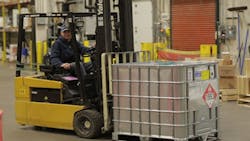The Hidden Hazards of Improperly Stored Intermediate Bulk Containers
When Intermediate Bulk Containers (IBCs) containing flammable and combustible liquids fail they can create a fire hazard—one that is often unknown to warehouse and facility personnel. When such IBCs fail, they release large pools of hazardous liquids. If ignited, the rapid heat release rates can overtax most fire sprinkler systems and spread before emergency personnel can arrive. Composite IBCs can also be easily breached by exposure to even a small fire. Additionally, once the unit empties, the composite IBC may ignite and contribute to the fire.
Misunderstood Rules Add Risk
The disparity between the rules governing the storage and transportation of IBCs can create a hidden hazard in warehouses and facilities. The U.S. Department of Transportation (DOT) and United Nations (UN) permit a variety of IBC types for transporting flammable and combustible liquids, but these rules do not cover or permit the storage of these hazardous liquids in IBCs once they arrive at a warehouse or indoor facility. Most DOT and UN certified IBCs in use are unlisted and unlabeled, meaning they have not been fire tested. Storing them in large quantities can thus lead to fires.
While most facility managers and personnel are unaware of this risk and what can be done about it, there are NFPA standards in place to help reduce the possibility of a catastrophic fire.
NFPA 30 Rules Reduce Risk
These safety guidelines are outlined in NFPA 30, the Flammable and Combustible Liquids Code published by the National Fire Protection Association (NFPA). NFPA 30, Flammable and Combustible Liquids, adopted into law in most states, governs storage, handling and use of flammable and combustible liquids. Where applicable, the storage of combustible or flammable liquids in IBCs must meet NFPA 30 standards. As an example, according to NFPA 30, flammable liquids should never be placed in a non-metallic IBC and if combustible liquids are placed in a composite IBC it must be listed and labeled.
Four Steps to Stay Safe
To reduce the risk of IBC-linked pool fires, warehouse and facility managers can take the following steps to comply with NFPA 30 when receiving IBCs containing combustible or flammable liquids.
- Determine whether the IBC is in or will eventually enter a protected facility. NFPA 30 rules and regulations define protected facilities and their requirements. These requirements include, but are not limited to, increased levels of sprinklers or other protections.
-
Identify the liquids to be stored. Determine if the liquids to be stored are:
--NFPA 30 Class I (flammable – flash point 100 degrees F)
--NFPA 30 Class II (combustible – flash point 100-140 degrees F)
--NFPA 30 Class III (combustible – flash point 140 degrees F and higher). - Identify the IBC material. Determine if the IBC is metal, rigid plastic or composite. If the container is composite, be sure that it is listed and labeled. Determine if the IBC material is appropriate for storage of its contents in a protected facility.
- If any of the NFPA 30 Class I liquids are being stored or received in composite IBCs, switch to metal IBCs. If any Class II or Class III liquids are stored or being received in unlisted IBCs, you can comply with NFPA 30 by switching to listed composite or metal IBCs.
Additionally, NFPA, the Fire Protection Research Foundation (FPRF) and the insurance industry in April launched the Contain IBC Fire Risk campaign to educate impacted groups and encourage their compliance with NFPA 30.
What You Can Do
Warehouse and facility managers are encouraged to join and take an active role in this effort. Some activities they may consider include:
- Educate employees or colleagues on the issue
- Incorporate information about the IBC pool fire risk into any employee trainings
- Educate and urge clients to follow NFPA 30
- Make a commitment to safe storage by establishing policies to ensure a facility complies with NFPA 30
- Work with an insurance representative to audit a facility and operations to verify NFPA 30 compliance and establish a regular inspection schedule, track progress and reward improvements
Lorraine Carli is vice president of outreach and advocacy for the National Fire Protection Association. Visit https://www.nfpa.org/ibc to learn more about IBC fire risks and to find a free informational toolkit to assist you in your awareness activities.
To watch MH&L's video gallery, "Bulk Container Handling Hazards Caught on Video," CLICK HERE.

